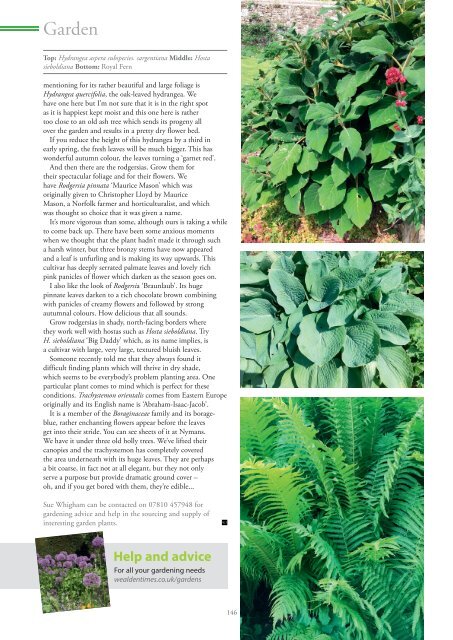Wealden Times | WT197 | July 2018 | Interiors supplement inside
Wealden Times - The lifestyle magazine for the Weald
Wealden Times - The lifestyle magazine for the Weald
Create successful ePaper yourself
Turn your PDF publications into a flip-book with our unique Google optimized e-Paper software.
Garden<br />
Top: Hydrangea aspera subspecies. sargentiana Middle: Hosta<br />
sieboldiana Bottom: Royal Fern<br />
mentioning for its rather beautiful and large foliage is<br />
Hydrangea quercifolia, the oak-leaved hydrangea. We<br />
have one here but I’m not sure that it is in the right spot<br />
as it is happiest kept moist and this one here is rather<br />
too close to an old ash tree which sends its progeny all<br />
over the garden and results in a pretty dry flower bed.<br />
If you reduce the height of this hydrangea by a third in<br />
early spring, the fresh leaves will be much bigger. This has<br />
wonderful autumn colour, the leaves turning a ‘garnet red’.<br />
And then there are the rodgersias. Grow them for<br />
their spectacular foliage and for their flowers. We<br />
have Rodgersia pinnata ‘Maurice Mason’ which was<br />
originally given to Christopher Lloyd by Maurice<br />
Mason, a Norfolk farmer and horticulturalist, and which<br />
was thought so choice that it was given a name.<br />
It’s more vigorous than some, although ours is taking a while<br />
to come back up. There have been some anxious moments<br />
when we thought that the plant hadn’t made it through such<br />
a harsh winter, but three bronzy stems have now appeared<br />
and a leaf is unfurling and is making its way upwards. This<br />
cultivar has deeply serrated palmate leaves and lovely rich<br />
pink panicles of flower which darken as the season goes on.<br />
I also like the look of Rodgersia ‘Braunlaub’. Its huge<br />
pinnate leaves darken to a rich chocolate brown combining<br />
with panicles of creamy flowers and followed by strong<br />
autumnal colours. How delicious that all sounds.<br />
Grow rodgersias in shady, north‐facing borders where<br />
they work well with hostas such as Hosta sieboldiana. Try<br />
H. sieboldiana ‘Big Daddy’ which, as its name implies, is<br />
a cultivar with large, very large, textured bluish leaves.<br />
Someone recently told me that they always found it<br />
difficult finding plants which will thrive in dry shade,<br />
which seems to be everybody’s problem planting area. One<br />
particular plant comes to mind which is perfect for these<br />
conditions. Trachystemon orientalis comes from Eastern Europe<br />
originally and its English name is ‘Abraham-Isaac-Jacob’.<br />
It is a member of the Boraginaceae family and its borageblue,<br />
rather enchanting flowers appear before the leaves<br />
get into their stride. You can see sheets of it at Nymans.<br />
We have it under three old holly trees. We’ve lifted their<br />
canopies and the trachystemon has completely covered<br />
the area underneath with its huge leaves. They are perhaps<br />
a bit coarse, in fact not at all elegant, but they not only<br />
serve a purpose but provide dramatic ground cover –<br />
oh, and if you get bored with them, they’re edible...<br />
Sue Whigham can be contacted on 07810 457948 for<br />
gardening advice and help in the sourcing and supply of<br />
interesting garden plants.<br />
Help and advice<br />
For all your gardening needs<br />
wealdentimes.co.uk/gardens<br />
146


















